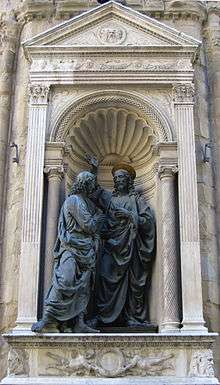Christ and St. Thomas (Verrocchio)
| Christ and St. Thomas (cast shown in original location) | |
|---|---|
 | |
| Artist | Andrea del Verrocchio |
| Year | 1467–1483 |
| Type | Bronze |
| Dimensions | 230 cm (91 in) |
| Location | Orsanmichele, Florence |
Christ and St. Thomas (1467–1483) is a bronze statue by Andrea del Verrocchio made for one of the 14 niches on the exterior walls of the Orsanmichele in Florence, Italy, where it is now replaced by a cast and the original moved inside the building, which is now a museum. It shows the episode that gave rise to the term "Doubting Thomas" which, formally known as the Incredulity of Thomas, had been frequently represented in Christian art since at least the 5th century, and used to make a variety of theological points. Thomas the Apostle doubted the resurrection of Jesus and had to feel the wounds for himself in order to be convinced (John 20:24-29). The surrounding marble niche was designed by Donatello for his St Louis of Toulouse (1413), but the statue was moved to Santa Croce when the niche was sold to the Tribunale di Mercanzia (merchant's guild), who commissioned the Verrochio work.
Style
The work was the first narrative based work to appear at Orsanmichele. In its execution Verrocchio showed sophisticated knowledge of the style and substance of classical sculpture. The figures were cast without backs (i.e., not in the round) as they were only to be viewed from the front. This had the added benefits of saving on bronze (which was roughly ten times more expensive than marble), making the work lighter and easier to fit into the niche.
The interaction between the characters of Christ and St Thomas show a strong sense of movement and dialogue. Differences between the mortal and the immortal are highlighted with Christ's passive, almost regal stance and the agitated and nervous disposition of the doubting St Thomas. The realism created by the artist is indicative of the period of art in which it was made, the Renaissance.
Mercanzia
Part of the remit of the Merchant's guild was to be a judicial, overseeing body. As such the theme of Christ and St Thomas would have been attractive to them as it concerned proof and the presentation of indefatigable evidence.
References
- Hartt, Frederick and Wilkins, David G. History of Italian Renaissance Art. Upper Saddle River, NJ: Pearson Prentice Hall, 2006.
Coordinates: 43°46′14.63″N 11°15′18.92″E / 43.7707306°N 11.2552556°E